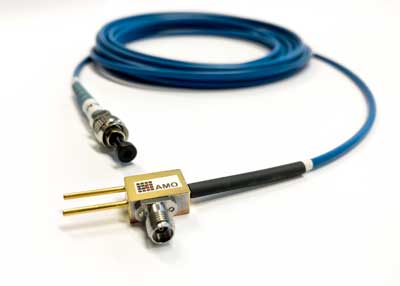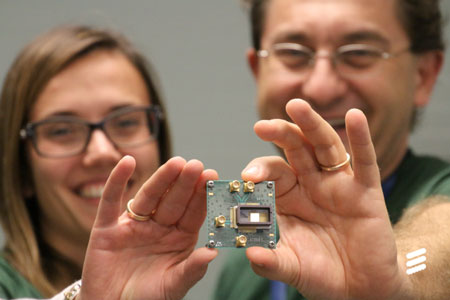| Posted: Feb 27, 2018 |
Ultra-fast graphene photonics for next generation datacomms
(Nanowerk News) On show for the first time at the GSMA Mobile World Congress are two graphene based photonics devices which give a glimpse into the future of data communications. At the Graphene Pavilion, experience the world’s first all-graphene optical communication link operating at a data rate of 25 Gb/s per channel and at the Ericsson stand discover the first ultrafast graphene-based photonic switches in an Ericsson testbed. These graphene-based photonic devices are the potential building blocks of the next generation of mobile networks, leading to ultrafast data streams with extreme bandwidth which are essential for a data-driven future
|
 |
| All-graphene optical communication link demonstrator operating at a data rate of 25 Gb/s per channel.
|
|
Optical data communication is at the heart of today’s information society, be it transmitting data as pulses of light through fibre-optic cables or storing data on an optical readable medium. As the world strives to meet the demand for ever increasing data transmission rates, more efficient data links hold the key. Within the European Graphene Flagship, the electronic and optic properties of graphene are used to fabricate optical communication devices at an entirely new performance level. The Graphene Flagship strives to bring together researchers from academia and industry to accelerate innovation. The importance of this can will be shown by the results produced by the collaboration between Graphene Flagship partners AMO GmbH (Germany), CNIT (Italy), Ericsson (Sweden), Imec (Belgium), Nokia (Italy) and Nokia Bell Labs (Germany).
|
|
"5G will all be about optical communications, and the realisation of the ultrafast optical communication link with graphene is a real breakthrough. It is very exciting that it is already on display at the Ericsson stand,” said ICREA Professor Frank Koppens from ICFO (The Institute of Photonic Sciences), Barcelona, the Scientific Chair of the Graphene Pavilion.
|
|
This year the Graphene Flagship presents the world’s first all-graphene optical communication link operating at a data rate of 25 Gb/s per channel. The key aspect of this demonstration is that all active electro-optical operations are performed by graphene devices. On the transmitter side a graphene modulator encodes an electronic data stream onto an optical carrier, then transferred to the receiver through an optical fibre. The receiver contains a graphene photodetector that converts the incoming optical data signal back into an electronic signal. This first demonstration of data transmission at a speed of 25 Gb/s can be experienced at the Graphene Pavilion at Mobile World Congress.
|
|
“The current challenge for graphene photonics is to develop a fabrication technology that enables not only single devices with superior performance but mass production of millions of devices. With the all graphene datalink we take a significant step towards this goal because we demonstrate that devices fabricated using volume production techniques are functional in a real configuration,” said Daniel Schall from AMO GmbH.
|
|
“This demonstration of a state-of-the-art photonic data link is a significant step ahead, as it demonstrates the system compatibility of an all graphene based solution,” said Daniel Neumaier from AMO GmbH, the leader of the Graphene Flagships Division on Electronics and Photonics Integration.
|
|
Seamless integration of graphene photonic components into existing communication environments is key for the next generation of data transfer. Ericsson will show the first graphene-based optical ultrafast interconnection in mobile access networks, with power efficient optical switching performance by overcoming the need of thermal control. A first prototype of a functional graphene-based photonic switch, designed to be applicable in datacomms and 5G networks, will be showcased. The device works in an Ericsson testbed equipped with commercial 100 Gb/s transceivers cards and Dense Wavelength Division Multiplexing (DWDM) network interconnection, operative in the C band and performing over 50 GHz fixed grid.
|
 |
| Antonio D’Errico and Teresa Pepe, showing graphene-based photonic switch.
|
|
“The basic switch element showcased by Ericsson at Mobile World Congress 2018 aims to be a significant step towards enabling a wide range of advanced services over a feature-rich optical network, while keeping the overall cost low, increase transmission capacity, and reduce latency to the benefit of the telecom operators and their customers,” said Antonio D’Errico, Senior Researcher, Ericsson.
|
|
“The Graphene Flagship has identified graphene-based integrated photonics as one of the key areas for future growth and investment, and has developed a roadmap matching the technology readiness requirements with the datacom and telecom market demands. This year we are proud to present, as a results of a close collaboration between leading industrial and academic partners of the Flagship, the first viable examples of graphene-based integrated photonics. This could lead to ultra-high spatial density, low power consumption for board and intra datacenter connectivity, access networks, metro, core, regional and long haul optical communications,” said Professor Andrea Ferrari, Graphene Flagship Science and Technology Officer and Chair of its Management Panel.
|
|
The Mobile World Congress is the world's largest gathering for the mobile industry and the Graphene Pavilion, organised by the Graphene Flagship, curated by ICFO and supported by the European Commission and the GSMA, gives attendees a glimpse into the future of mobile technologies enabled by graphene and related materials. Hosting 26 exhibiting partners from across Europe the Graphene Pavilion is a true testament to the ground-breaking work being undertaken within the Graphene Flagship. The Graphene Flagship is one of Europe’s largest research initiatives, aimed at taking graphene and related materials from the realm of academic laboratories to the factory floor.
|


